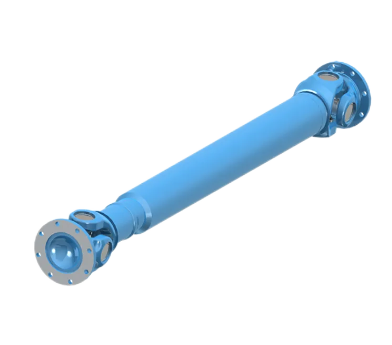Core Definitions: Understanding Flexible and Rigid Couplings
What is a Flexible Coupling?
Flexible couplings basically connect two shafts together but let them move around a bit when things get out of line. These components show up everywhere from factory machinery to car engines wherever alignment shifts happen because of temperature changes or vibration issues. Most manufacturers go with rubber, polyurethane, or composite materials since they bend without breaking and hold up over time. There's actually quite a few different kinds out there too – elastic couplings for light duty work, grid type for heavy industrial jobs, and beam style that handles angular misalignment really well. Take a look at any modern assembly line or robotic system and chances are good someone installed flexible couplings somewhere behind the scenes. They help keep everything running smoothly longer by absorbing those little shocks and movements that would otherwise wear down gears and bearings faster than normal.
What is a Rigid Coupling?
Rigid couplings basically join two shafts together solidly without any room for misalignment, which makes them great at transferring torque efficiently. Most commonly made from strong metals like steel or aluminum, these components stand out because they just don't give way under stress and last a long time. There are several different kinds on the market too – think sleeve couplings, clamp types, and those old school muff designs – each suited for situations where getting the shafts perfectly aligned matters most. Industries that need pinpoint accuracy rely heavily on these connections, especially places like aerospace manufacturing or anywhere fast moving equipment operates. Despite being pretty stiff in how they work, rigid couplings still manage to pass along power between shafts without any interruptions. Want to know more? Check out our detailed guide on rigid coupling systems.
Functional Differences in Power Transmission
Torque Transmission Capabilities
The way torque gets transmitted varies quite a bit when comparing flexible versus rigid couplings. Rigid types pass on torque straight through with no losses at all, which makes them perfect for situations needing exact measurements and top notch efficiency. Flexible couplings do give operators more freedom with alignment issues but they tend to lose some torque because of how bendy they are. Research shows that rigid models beat out flexible ones when it comes to transmitting power efficiently throughout different operating scenarios. Take numbers for example: most rigid couplings hit about 95% efficiency in transferring torque, while flexible options usually hover around 85% under comparable conditions. This difference matters a lot in industrial settings where every bit of efficiency counts.
Vibration Absorption and Shock Load Handling
Keeping machines running smoothly depends a lot on absorbing vibrations, and that's where flexible couplings really shine. Unlike their rigid counterparts which just pass all those vibrations straight along the shafts, flexible ones actually soak up and spread out those forces, so parts don't get worn down as fast. The numbers back this up too flexible couplings deal with sudden impacts way better than other types, which means fewer repairs needed and machines working harder for longer periods. Most engineers will tell anyone who listens that these vibration dampening properties make all the difference in places like robot assembly lines or factory floors. Even small reductions in shock transmission can translate into much longer lasting equipment over time, something manufacturers track closely when planning maintenance schedules.
Misalignment Compensation Mechanisms
One major benefit of flexible couplings lies in their ability to compensate for misalignments. These components can handle angular offsets, parallel shifts, and even some axial movement between connected shafts, which helps cut down on machine wear over time. The shipping industry especially appreciates this feature since vessels constantly experience vibrations and movements at sea. Construction equipment operators face similar challenges when working on uneven ground conditions. Industry reports show that traditional rigid couplings tend to fail more often in installations where perfect alignment simply isn't possible. Flexible alternatives stand up better to these stresses, meaning fewer breakdowns and less frequent maintenance requirements for systems running around the clock in manufacturing plants or other heavy industrial settings.
Industrial Applications and Use Cases
Where Rigid Couplings Excel
Industries needing rock solid precision and stability turn to rigid couplings all the time, especially in areas like precision machinery work, cars, and planes. What makes these couplings so valuable? They transmit torque without losing energy, which matters a lot when every detail counts. Take cars for example. The rigid couplings keep power flowing smoothly from engine to wheels, so vehicles run better and get better mileage. And this isn't just theory. Look at airplanes where even tiny issues with torque can lead to big problems. Researchers at MIT's aerospace engineering department found something interesting too. When aviation companies switched to rigid couplings, they saw lower maintenance bills and systems that lasted longer between repairs. So if an application needs serious torque handling and wants to avoid constant maintenance headaches, most engineers will go with rigid couplings because they just work better over time.
Optimal Scenarios for Flexible Couplings
Flexible couplings work really well in places where there are variable speed drives and lots of vibration going on. These components shine when dealing with equipment that experiences big swings in load, which happens all the time in mining and construction work. Take mining for instance the machines down there deal with crazy load variations throughout the day. Flexible couplings help absorb those shocks and keep the whole system running longer without breaking down. On construction sites, these couplings can handle sudden vibrations from heavy machinery starting up or shutting down, which means fewer breakdowns and less money spent on repairs. Some research published in the Journal of Construction Engineering found that companies using flexible couplings saw about 25% less downtime across their fleet. The main point here is simple flexibility equals reliability. When industrial operations face unpredictable conditions, having components that can adjust to changing loads makes all the difference in keeping production moving forward.
Performance Trade-Offs: Advantages and Limitations
Benefits of Rigid Couplings in Precision Systems
In high precision systems, rigid couplings have several benefits that make them the go to option for applications needing tight tolerances and little to no backlash. When installed correctly, these mechanical connections create a solid link between rotating shafts which improves how torque gets transferred throughout machinery. Looking at actual performance metrics over time, rigid models tend to last longer than their flexible counterparts, especially when used in situations where precise alignment matters most and vibrations need to stay low. Industry professionals who work with industrial equipment day in and day out often point to rigid couplings as dependable solutions because they just work so well in maintaining system stability when accuracy counts the most. Many maintenance teams report fewer breakdowns and better long term results from using this type of coupling in critical applications.
Flexible Coupling Advantages in Dynamic Environments
Flexible couplings really shine when dealing with those tough environments full of changing workloads and constant vibrations. What makes them so valuable is how they handle misalignment issues and soak up shocks without breaking a sweat. This matters a lot for machines that run at different speeds or carry varying loads throughout the day. Take mining operations or construction sites for instance, plus all sorts of variable speed drive systems. These real world applications show just how critical flexible couplings actually are. Companies report saving money over time because there's less need for maintenance and fewer unexpected shutdowns. The bottom line? Flexible couplings pay off in the long run despite their initial costs, especially when working under harsh conditions that would wear out other components much faster.
Maintenance Requirements Comparison
Looking at maintenance needs for rigid versus flexible couplings shows that flexible ones usually need checking more often because they move around during operation. Studies from the field suggest while these flexible models do demand more regular attention, rigid couplings can actually end up costing more in the long run when alignment problems develop. Maintenance matters for both kinds though. If companies skip on proper upkeep, they'll face serious downtime issues. We've seen plenty of situations where factories ignored basic maintenance routines for either coupling type and wound up with major production delays and repair bills.
Selection Criteria for Optimal Performance
Assessing Torque and Speed Requirements
Choosing the right coupling starts with looking at torque and speed needs across different industrial settings. Getting this right means finding a coupling that keeps things running smoothly without breaking down unexpectedly. Take automotive manufacturing for instance where machines spin at incredible speeds. These setups need couplings built to handle exact torque levels so components don't wear out too fast. Alignment issues here really matter because misaligned parts just won't perform well. Flexible couplings generally cant take as much torque as their rigid counterparts, though they work better when some movement is expected. Most engineers will tell anyone working on machinery to check those torque specs carefully for whatever application they're dealing with. Good design choices help avoid those costly alignment problems that eat away at system efficiency over time.
Evaluating Alignment Conditions
Getting the alignment right when choosing couplings matters a lot for their performance down the road. When things aren't aligned properly, it really affects how well they work and how long they last before breaking down or wearing out too fast. Most shops rely on tools like laser alignment equipment and dial indicators to get accurate readings so everything runs smoothly. Even small alignment issues can cut short the life expectancy of both rigid and flexible couplings by quite a margin in real world applications. Industry veterans know this all too well from years of dealing with breakdowns caused by poor alignment. Sticking to good alignment practices saves money on repairs and keeps operations running reliably day after day. Following these basic maintenance steps ensures machines stay operational longer while delivering better results overall.
Environmental Factors and Material Considerations
When picking coupling materials, environmental factors matter a lot. Things like temperature swings, moisture levels, and chemicals in the air all play into how well couplings perform over time. Some environments just eat away at certain materials faster than others. Take corrosion-prone areas for example aluminum or stainless steel tend to hold up better there. But when temps get really hot, different materials come into play specific polymers or special alloys work better under those conditions. The oil and gas sector is a good case study since equipment there deals with intense heat regularly. That's why we see so much stainless steel in those applications. Industry standards help point people in the right direction too. They basically act as roadmaps for what works where. Most engineers check these guidelines first before making final decisions about which materials will survive the long haul without failing spectacularly.
FAQ
What are the main differences between flexible and rigid couplings?
Flexible couplings allow for some degree of misalignment and movement between two connected shafts, making them suitable for environments where such conditions are anticipated. Rigid couplings, on the other hand, provide a firm connection with no allowance for misalignment, ideal for precise torque transmission applications.
Which industries typically use flexible or rigid couplings?
Flexible couplings are commonly used in industries like automotive, manufacturing, and robotics due to their ability to manage dynamic shaft alignments. Rigid couplings excel in aerospace, automotive, and high-speed machinery sectors where precision and stability are crucial.
How do environmental factors influence coupling selection?
Environmental factors such as temperature, humidity, and chemical exposure can affect coupling performance and lifespan. Material selection is critical, with options like aluminum and stainless steel being suitable for corrosion-prone environments, while polymers and alloys may be needed for high-temperature scenarios.

